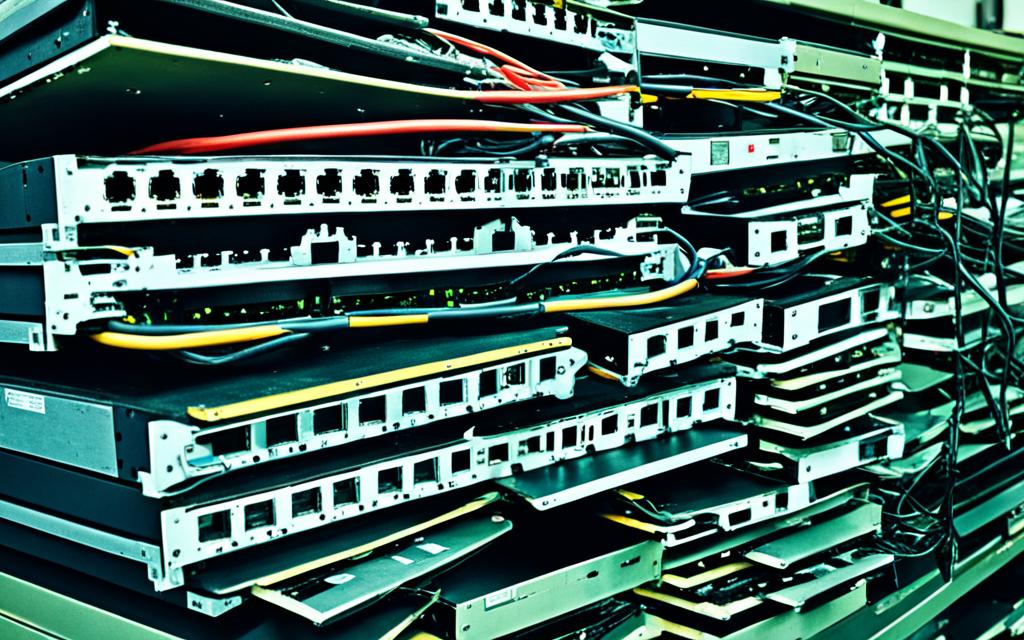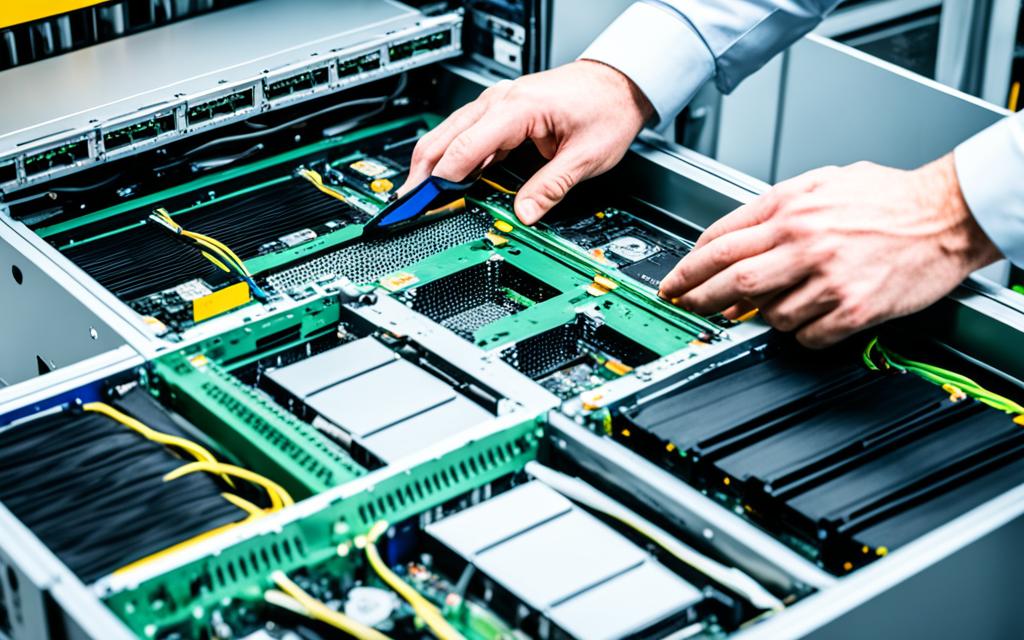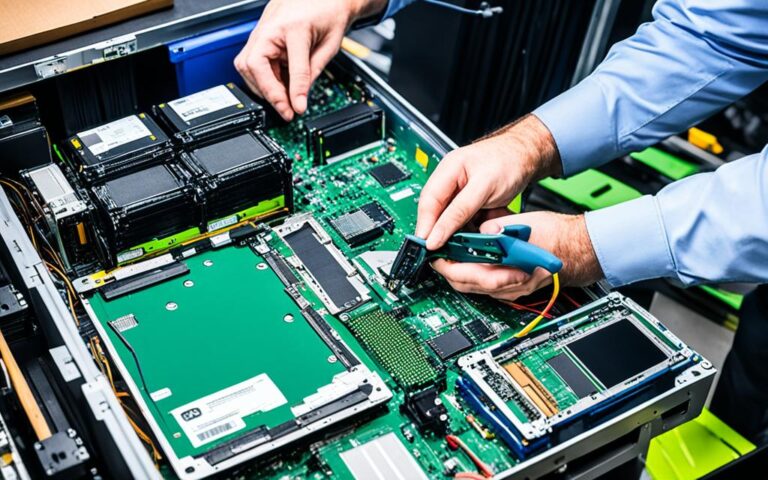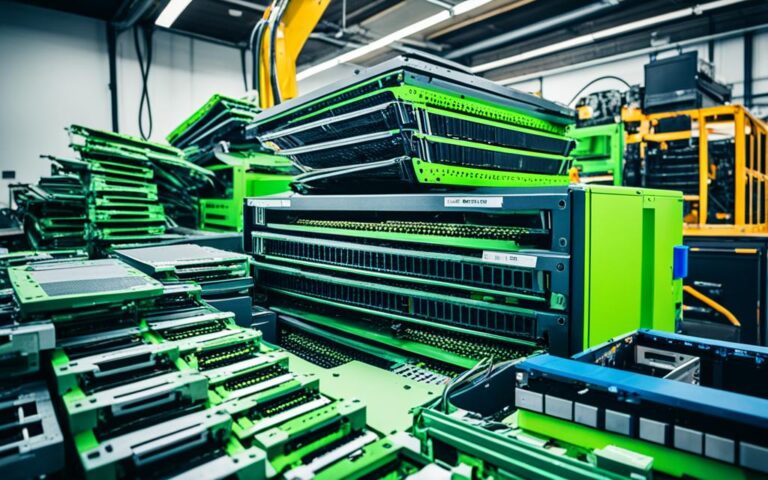Server Recycling: Best Practices for Secure Data Erasure
Welcome to our comprehensive guide on server recycling, where we will explore the best practices for secure data erasure. In today’s rapidly evolving technological landscape, businesses face the challenge of responsibly disposing of outdated servers while protecting sensitive information.
As a responsible business, it is imperative to prioritize secure data erasure to ensure the confidentiality of customer data and comply with data protection regulations. By understanding and implementing best practices, you can effectively manage your IT assets and contribute to environmental sustainability.
Throughout this guide, we will delve into key areas such as data destruction, storage media assessment, effective sanitization techniques, environmental practices, data security, and responsible asset management. By following these best practices, you can mitigate the risk of data breaches, reduce e-waste, and align with regulatory requirements.
Join us on this journey to discover how you can make a positive impact on both your business and the environment through responsible server recycling. Let’s dive in!
Understanding Data Destruction Best Practices
Before delving into the best practices for data destruction, it is important to understand the key consideration areas. These areas include functional efficacy, costs, environmental impact, health and safety compliance, and regulatory compliance. By evaluating these factors, organizations can determine the best practices that align with their specific needs and goals.
Functional Efficacy
Functional efficacy refers to the effectiveness of the data destruction process in completely eradicating sensitive information from storage devices. It involves selecting methods that ensure all data is irreversibly removed, leaving no trace behind.
Costs
Cost considerations involve analyzing the expenses associated with different data destruction techniques. Organizations should compare the costs of implementing secure data erasure practices against potential data breaches, which can result in financial losses, reputational damage, and regulatory penalties.
Environmental Impact
The environmental impact of data destruction practices should not be overlooked. Organizations should choose methods that minimize harm to the environment, such as opting for techniques that promote recycling and responsible disposal of electronic waste.
Health and Safety Compliance
Health and safety compliance ensures that data destruction processes do not pose any risks to employees or the environment. Organizations should adhere to relevant health and safety guidelines, providing appropriate training and protective measures for employees involved in data destruction activities.
Regulatory Compliance
Regulatory compliance involves following industry-specific regulations and standards for data destruction. Organizations must understand and comply with the legal requirements of their jurisdiction to avoid legal liabilities and penalties.
By carefully considering these key areas, organizations can establish data destruction best practices that are efficient, cost-effective, environmentally responsible, and compliant with relevant regulations. This ensures that sensitive information is securely erased, reducing the risk of data breaches and protecting the reputation of the organization.
Assessing Storage Media and Device Configuration
Before proceeding with data destruction methods, it is crucial to assess the storage media and device configuration. A thorough audit of the devices is necessary to identify all types of storage media, including hard drives, solid-state drives (SSDs), and other removable media. Understanding the specific storage media used in each device is essential for choosing the appropriate data destruction techniques.
The National Institute of Standards and Technology (NIST) offers comprehensive guidelines for storage media assessment. The NIST SP 800-88 guideline provides a media sanitization matrix that maps different techniques to various storage media types. By referring to these guidelines, organizations can ensure the selection of the most suitable methods for data destruction.
Moreover, assessing the device configuration is equally important. Before initiating the data destruction procedure, organizations should determine the initial configuration of each device. This includes identifying the operating system, software applications, network connections, and any other relevant device settings. Understanding the device configuration ensures that the data destruction methods chosen are compatible and effective for the specific device.
For accurate assessment, organizations can consult the NIST guidelines and the recommendations provided by the device manufacturers. These resources offer valuable insights and best practices for evaluating storage media and device configuration.
Data Destruction Techniques
| Data Destruction Technique | Storage Media | Effectiveness |
|---|---|---|
| Data Wiping | Hard Drives, SSDs | High |
| Degaussing | Magnetic Media (Tapes, HDDs) | High |
| Physical Destruction | All Storage Media | High |
Effective Sanitization Techniques
Secure data erasure is a crucial aspect of server recycling. To ensure the protection of sensitive information, organizations can employ various sanitization techniques. These techniques include:
- Data Wiping: This technique involves overwriting all data on storage devices to ensure that no trace of the original data remains. Data wiping is an effective way to prevent data recovery and protect confidential information.
- Degaussing: Degaussing is another sanitization technique used to make hard drives unreadable. It involves demagnetizing the hard drive, rendering the data inaccessible. This method is particularly useful for magnetic storage media.
- Physical Destruction: Physical destruction, such as shredding or crushing the hard drives, is a reliable method to ensure that data cannot be recovered. This technique physically destroys the storage media to render the data irretrievable.
When employing these sanitization techniques, it is vital for organizations to use tools and methods that adhere to recognized industry standards. The NIST (National Institute of Standards and Technology) Special Publication 800-88 provides guidelines and recommendations for secure data erasure. Compliance with these standards ensures that organizations meet the highest level of data security during the server recycling process.
Incorporating effective sanitization techniques as part of server recycling practices enables organizations to safeguard sensitive data, reduce the risk of data breaches, and comply with regulatory requirements.
“Effective data sanitization techniques are essential in ensuring that sensitive information is protected during server recycling. Employing practices such as data wiping, degaussing, and physical destruction guarantees that data cannot be retrieved, minimizing the risk of unauthorized access and potential breaches.”
Environmental and Sustainable Practices
In today’s world, environmental responsibility is paramount. It is our duty to protect the planet and ensure a sustainable future for generations to come. When it comes to server recycling, embracing sustainable practices is crucial. Not only does this help reduce electronic waste (e-waste), but it also allows us to recover valuable resources and minimize our impact on the environment.
Resource recovery plays a vital role in sustainable server recycling. By extracting valuable materials from server components and reusing them, we contribute to the circular economy. This process minimizes waste and reduces the need for extracting new raw materials, thus conserving valuable resources. It’s a win-win situation for both the environment and our economy.
To ensure the responsible disposal of remaining materials, it is essential to partner with certified recycling facilities. These facilities adhere to industry standards and regulations, guaranteeing that the recycling process is carried out ethically and responsibly. By choosing certified recycling, we can be confident that our servers are handled in an environmentally sound manner.
By adopting environmental responsibility, resource recovery, and certified recycling, we can make a significant impact on the sustainability of server recycling. Let’s work together to create a greener and more sustainable future.
Data Security and Compliance
Data security and regulatory compliance are of utmost importance when it comes to server recycling. To safeguard sensitive information from unauthorized access and minimize the risk of data breaches, organizations need to prioritize secure data erasure. In addition, complying with local and international e-waste regulations is essential to avoid financial penalties and legal consequences.
Secure data erasure practices play a crucial role in maintaining a robust data protection strategy and meeting regulatory requirements. By effectively erasing data from outdated servers, organizations can ensure that confidential information is no longer accessible, even after disposal.
Implementing secure data erasure practices is not only vital for protecting data privacy but also demonstrates a commitment to responsible IT asset management. It is an essential step towards maintaining the trust of customers, clients, and stakeholders.
Organizations should adopt industry best practices and standards for secure data erasure during server recycling. This includes following recognized methods such as data wiping, degaussing, and physical destruction, which comply with reputable guidelines like the NIST Special Publication 800-88.
By prioritizing data security and compliance in server recycling, organizations can mitigate the risk of data breaches, protect sensitive information, and maintain a strong reputation for responsible and ethical disposal practices.
Sustainable Asset Management
Responsible IT asset management is the cornerstone of sustainable practices when it comes to retiring devices. Rather than prematurely discarding devices, organizations can repurpose or reuse them for less demanding tasks, extending their lifespan and reducing waste. By upgrading components such as RAM or hard drives, businesses can breathe new life into these devices, maximizing their value and minimizing their environmental impact.
Furthermore, donating older functional devices to schools or nonprofit organizations provides an opportunity to support the community while ensuring that these devices continue to serve a purpose. Employee purchase programs also play a crucial role in ensuring that devices don’t go to waste, allowing employees to acquire and utilize retired devices for personal use.
Adopting sustainable asset management practices brings numerous benefits. Not only does it contribute to environmental sustainability by reducing electronic waste, but it also fosters a culture of resourcefulness and community support within organizations.
“By repurposing and donating devices, organizations can make a positive impact on both the environment and their surrounding communities.”
By taking a proactive approach to responsible IT asset management, businesses play an active role in the circular economy and pave the way for a greener, more sustainable future.
| Benefits of Sustainable Asset Management | Examples |
|---|---|
| Environmental Sustainability | Reduced electronic waste |
| Cost Savings | Avoidance of unnecessary device purchases |
| Community Support | Donation programs to schools and nonprofits |
| Resourcefulness | Repurposing devices for less demanding tasks |
Sustainable asset management aligns with the values of responsible IT asset management, creating a win-win situation for both the organization and the environment.
Key Takeaways:
- Responsible IT asset management involves repurposing and reusing devices to reduce waste.
- Upgrading components and donating functional devices can extend their lifespan and benefit the community.
- Employee purchase programs ensure devices are put to good use and avoid unnecessary waste.
- Sustainable asset management supports environmental sustainability, cost savings, community support, and resourcefulness.
Conclusion
The process of server recycling is of utmost importance, requiring secure data erasure and responsible IT asset management. By implementing the best practices for data destruction, assessing storage media and device configuration, utilizing effective sanitization techniques, and prioritizing environmental sustainability and data security, organizations can successfully recycle servers while safeguarding sensitive information and minimizing their environmental impact.
Collaborating with trusted providers like Data Network is essential to ensure the secure and responsible disposal of outdated servers. Their expertise and adherence to industry standards guarantee that sensitive data is erased thoroughly, following recognized guidelines and protocols. Through their reliable services, organizations can confidently recycle servers while maintaining data confidentiality and integrity.
Responsible IT asset management is equally crucial in the server recycling process. By repurposing or reusing devices rather than prematurely discarding them, companies can extend their lifespan and reduce electronic waste. Upgrading specific components and donating functional devices to educational institutions or non-profit organizations are additional sustainable options. Employee purchase programs also encourage responsible disposal and maximize the value of outdated devices.
Ultimately, adopting secure data erasure practices, responsible IT asset management, and environmentally sustainable approaches in server recycling demonstrates a commitment to both data security and environmental preservation. By partnering with reputable service providers like Data Network and embracing the best practices outlined above, organizations can navigate the server recycling process with confidence and contribute to a sustainable and secure digital ecosystem.
FAQ
What is server recycling?
Server recycling is the process of disposing of outdated servers in a responsible and environmentally friendly manner.
Why is secure data erasure important during server recycling?
Secure data erasure is crucial during server recycling to protect sensitive information from unauthorized access and prevent data breaches.
What are the key consideration areas for data destruction?
The key consideration areas for data destruction include functional efficacy, costs, environmental impact, health and safety compliance, and regulatory compliance.
How can organizations assess storage media and device configuration?
Organizations can refer to the NIST guidelines and device manufacturer recommendations to properly assess storage media and determine the initial configuration of each device.
What are the effective sanitization techniques for secure data erasure?
Effective sanitization techniques for secure data erasure include data wiping, degaussing, and physical destruction, following recognized standards such as the NIST Special Publication 800-88.
How can organizations adopt environmental and sustainable practices during server recycling?
Organizations can follow sustainable practices such as resource recovery and partner with certified recycling facilities to ensure responsible disposal of remaining materials.
What role does data security and regulatory compliance play in server recycling?
Data security and regulatory compliance are crucial in server recycling to protect sensitive information and avoid fines and legal repercussions by complying with e-waste regulations.
How can organizations practice sustainable asset management during server recycling?
Sustainable asset management involves repurposing or reusing devices, donating functional devices to schools or nonprofits, and offering employee purchase programs to minimize waste.













